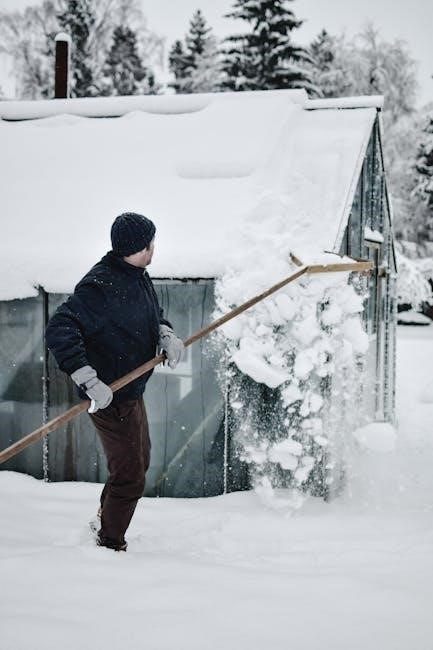winter preparedness checklist pdf

Winter Preparedness Checklist PDF: A Comprehensive Guide
Prepare for winter’s challenges with our comprehensive guide, available in PDF format.
This checklist covers essential steps for home winterization, emergency kit essentials,
vehicle preparedness, and family communication planning. Stay WinterReady by understanding
risks and taking proactive measures.
Understanding Winter Risks
Winter presents a unique set of risks that demand proactive preparedness. Identifying and
understanding these risks is the first crucial step in ensuring safety and well-being during
the colder months. Winter storms, for instance, can bring extreme cold, freezing rain, sleet,
heavy snowfall, ice, and high winds, all of which can disrupt daily life and pose significant
hazards.
One primary risk is the potential for power outages. Severe weather can damage power lines,
leaving homes without electricity for extended periods. This can impact heating, lighting, and
the ability to cook or communicate. Another significant risk is travel disruption. Snow and ice
can make roads treacherous, leading to accidents and delays.
Moreover, arctic air masses can encompass large regions, leading to dangerously low
temperatures. Prolonged exposure to cold can result in hypothermia and frostbite, especially
for vulnerable populations. Freezing rain and sleet can create hazardous conditions for
pedestrians and drivers alike. Understanding these risks allows for targeted preparation and
mitigation strategies, ensuring resilience in the face of winter’s challenges.
Home Winterization Checklist
Preparing your home for winter is essential to ensure safety, comfort, and energy efficiency.
A comprehensive winterization checklist helps you address critical areas and minimize potential
problems. Start by inspecting your home’s insulation. Proper insulation in attics, walls, and
crawl spaces can significantly reduce heat loss and lower energy bills. Seal any cracks or gaps
around windows and doors with weather stripping or caulk to prevent drafts.
Next, focus on your heating system. Schedule a professional inspection and tune-up for your
furnace or boiler to ensure it’s operating efficiently and safely. Clean or replace furnace
filters regularly to maintain optimal performance. Consider installing a programmable thermostat
to regulate temperature and save energy.
Protect your pipes from freezing by insulating exposed pipes in unheated areas. Let faucets
drip slightly during extremely cold weather to prevent pipes from bursting. Clear gutters and
downspouts of leaves and debris to prevent ice dams from forming, which can damage your roof.
Finally, check your smoke detectors and carbon monoxide detectors to ensure they are working
correctly and have fresh batteries.
Emergency Kit Essentials
An emergency kit is crucial for weathering winter storms and power outages.
Your kit should contain essential supplies to help you and your family stay safe and comfortable
until help arrives or the situation improves. Begin with a supply of non-perishable food items,
such as canned goods, energy bars, and dried fruits, sufficient for at least three days. Don’t
forget a manual can opener!
Water is paramount. Store at least one gallon of water per person per day for drinking and
sanitation. Include a first-aid kit with bandages, antiseptic wipes, pain relievers, and any
personal medications. A portable, battery-powered or hand-crank weather radio is essential for
receiving emergency alerts and updates.
Pack extra batteries for the radio and any other battery-operated devices. Warm clothing is
vital, including hats, gloves, scarves, and blankets. A flashlight is a must-have, along with
extra batteries. Consider including a multi-tool or utility knife for various tasks. Cash in
small denominations can be helpful if electronic payment systems are down. Finally, personal
hygiene items like soap, toothpaste, and toilet paper are essential for maintaining sanitation.

Vehicle Winter Preparedness Kit

A well-stocked vehicle emergency kit is essential for winter driving. If you become stranded,
it can provide the necessary supplies to stay safe and warm until help arrives. Start with a
cell phone charger to ensure you can contact emergency services. A flashlight with extra batteries
is crucial for visibility, especially during nighttime breakdowns.
Include jumper cables to jump-start your car if the battery dies. A first-aid kit is essential
for treating minor injuries. Pack warm blankets, hats, gloves, and scarves to protect against
the cold. Non-perishable food items, such as energy bars, nuts, and dried fruit, can provide
sustenance if you’re stranded for an extended period.
Keep a supply of water in your vehicle, but be mindful of freezing temperatures; A basic toolkit
with essential tools like a wrench, screwdriver, and pliers can be helpful for minor repairs.
Include an ice scraper and snow brush to clear your windshield and windows. Sand or kitty litter
can provide traction if your car gets stuck in snow or ice. Finally, consider carrying a
shovel for digging your car out if necessary.
Family Communication Plan
During winter storms, communication can be disrupted. A family communication plan ensures everyone
knows how to reach each other and where to meet if separated. Start by designating an out-of-state
contact person. This person can serve as a central point of contact if local communication lines
are down. Make sure everyone in the family has the contact information for this person.
Establish a meeting place in case you can’t return home. This could be a relative’s house, a
community center, or any safe location. Ensure everyone knows the address and directions to the
designated meeting place. Discuss different scenarios and how each family member should respond.
For example, what should children do if they are at school when a storm hits?
Consider alternative communication methods, such as text messaging or social media, which may
work even when phone lines are overloaded. Keep a list of important phone numbers and addresses
in a waterproof bag. Practice your communication plan regularly to ensure everyone is familiar
with it. Review and update the plan annually, especially as family members’ circumstances change.
Download our fillable form to quickly and easily create your family communication plan.
Cold Weather Car Essentials
Winter driving demands a well-prepared vehicle. Keep your gas tank at least half full to prevent
fuel line freezing and ice buildup. An emergency kit is crucial if you get stranded.
Include jumper cables, a flashlight with extra batteries, and a first-aid kit. A portable
charger for your phone is also essential for communication.

Pack warm blankets, hats, gloves, and scarves to protect against the cold. Non-perishable
food items like energy bars and bottled water can sustain you if you’re stuck for an extended
period. A shovel and ice scraper are necessary for clearing snow and ice from your windshield
and tires. Sand or kitty litter can provide traction if your tires are spinning on ice.
Consider a multi-tool or knife for various tasks. Road flares or reflective triangles can
alert other drivers to your presence. Check your tire pressure regularly, as it decreases in
cold weather. Ensure your windshield washer fluid is winter-rated to prevent freezing.
Always be prepared for unexpected situations with this checklist of car essentials.
Winter Storm Preparedness for People with Disabilities
Winter storms present unique challenges for individuals with disabilities. Planning ahead
is crucial for ensuring safety and well-being. Because winter storms come in all shapes and
sizes, and because they can come out of nowhere, it’s important to take steps now to prepare.
Assess your individual needs and develop a personalized preparedness plan.
Ensure you have an adequate supply of medications and medical equipment. If you rely on
electricity for medical devices, have a backup power source readily available. Register with
your local emergency notification system to receive timely alerts and updates. Coordinate
with family, friends, or caregivers to establish a support network.
Practice your emergency plan to familiarize yourself with the steps involved. Consider
mobility limitations and identify accessible shelters or evacuation routes. Keep assistive
devices readily accessible and ensure they are fully charged. Maintain a list of emergency
contacts and important medical information. The more prepared you are, the more resilient
you’ll be in the face of winter weather.
Facilities Winter Preparedness

Ensuring the readiness of facilities for winter weather is paramount for maintaining
operations and safeguarding personnel. Formulate a written emergency action plan and train
personnel in its use. Before the winter season, conduct a thorough inspection of the
facility to identify potential vulnerabilities.
Check the integrity of roofing, windows, and insulation to prevent heat loss and water
damage. Provide proper lubrication for cold weather operation for emergency generators and
snowblowers. Clear gutters and downspouts to ensure proper drainage. Inspect and maintain
heating systems, including boilers and furnaces, to ensure optimal performance.
Stockpile essential supplies such as snow removal equipment, de-icing agents, and emergency
lighting. Test cold-weather equipment regularly to verify functionality. Develop a snow
removal plan to maintain safe access to entrances and exits. Implement procedures for
addressing frozen pipes and water damage. By proactively addressing these measures,
facilities can minimize disruptions and ensure a safe environment throughout the winter
season.
Emergency Notification Systems
Effective emergency notification systems are critical for disseminating timely information
during winter weather events. Register your cell phone for emergency notifications to receive
alerts about severe weather warnings, road closures, and other important updates. The newly
updated FEMA App provides preparedness information and real-time alerts.
Utilize local news channels and weather apps to stay informed about approaching storms and
potential hazards. Establish a communication plan with family members and neighbors to ensure
everyone is aware of emergency procedures. Consider investing in a NOAA Weather Radio for
reliable weather information, even during power outages.
Implement a system for notifying employees or building occupants of emergencies, such as
text message alerts or public address announcements. Regularly test your notification
systems to ensure they are functioning properly. Familiarize yourself with community-level
emergency alerts and warning systems. By establishing and maintaining robust emergency
notification systems, you can enhance your ability to respond effectively to winter weather
emergencies and protect yourself and others.